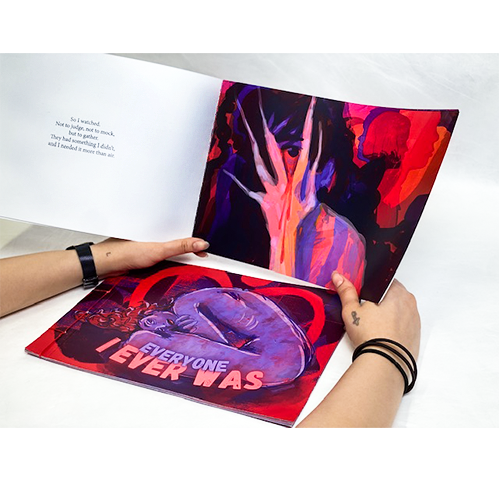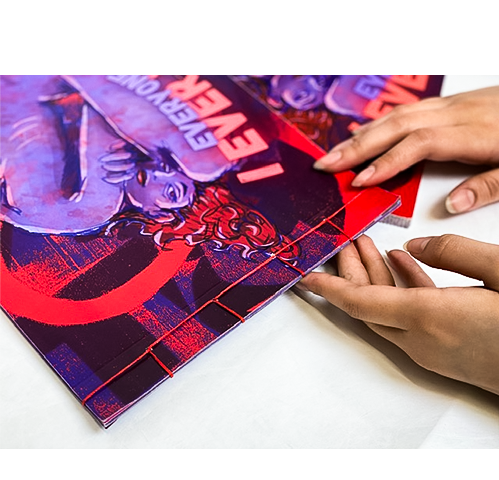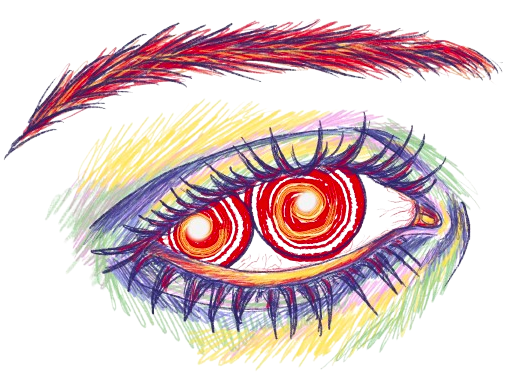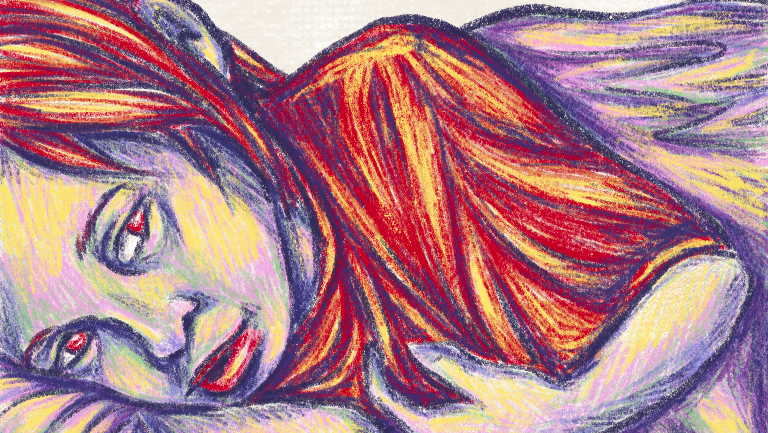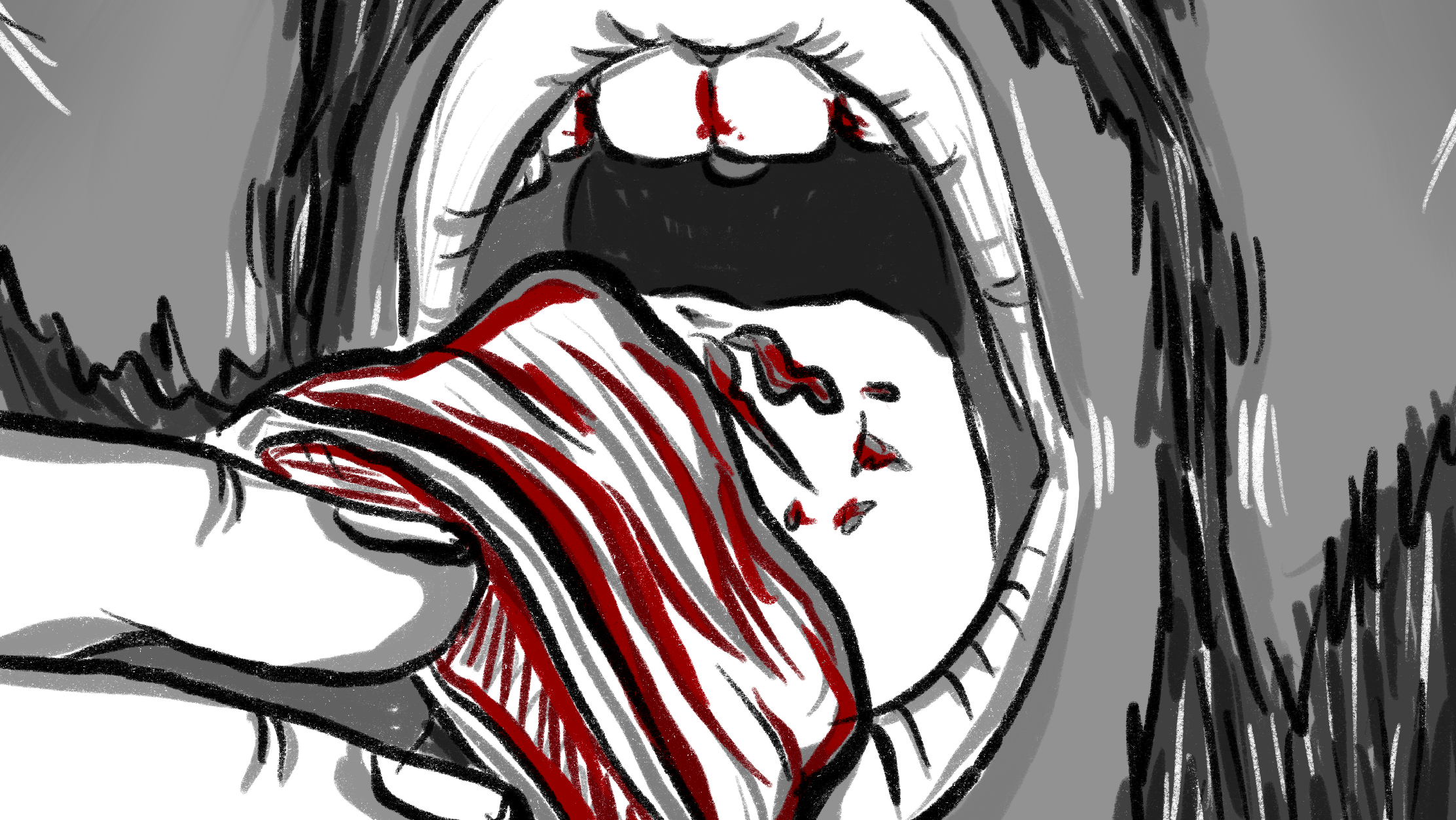The Brief


After reviewing the set of project briefs, I chose the theme of *belonging*. This brief resonated with me deeply, as I have a strong interest in people and social interactions. Being a social butterfly, I thrive on connecting with diverse individuals and engaging in meaningful conversations. At the same time, I have a tendency to overanalyze people, often creating an idealized version of their personalities in my mind. I felt this brief would provide an opportunity to explore why I gravitate toward crafting these glorified personas of my friends and why I focus so intensely on intricate details in my observations.
Initially, I wanted to explore my personal experience of not belonging to any specific place. As an Indian who grew up in Dubai, I often feel disconnected from both identities. My upbringing was shaped by my parents, who are extremely progressive, which made me more open-minded and understanding than many of the people I grew up around. This is part of why I enjoy living in the UK, but even here, I don’t feel like I truly belong.
I often feel caught between cultures—too "white" for Indian communities, too "Indian" for white communities, and unable to claim the UAE as home since they don’t grant citizenship. With my parents now living in two different countries and me living here, I’ve realized I don’t have a place I can truly call home. The more I reflected on this idea, the more it weighed me down, and ultimately, I decided to abandon it.
Unconscious Actions
After discussing my ideas with Kristian, I decided to focus on the unconscious or subconscious actions people do—those small, unnoticed gestures that often go overlooked but hold a special kind of charm. These micro-actions captivate me because they feel intimate, like I’m sharing a quiet, unspoken secret with myself. Observing something about someone that they’re completely unaware of gives me a sense of connection to them, even though it’s entirely one-sided. There’s a certain thrill in noticing these subtle, personal details and realizing they have no idea that I’ve picked up on them.
For instance, when someone taps their foot absentmindedly, spins a pen in their hand, or does a little body shake when they’re excited, I find myself thinking, “Oh, that’s cute—that’s something so unique .” These actions feel like small windows into a person’s authentic self, free from any self-consciousness or performance. It’s fascinating how such tiny behaviors can say so much about a person’s personality or emotional state.
Whether I decide to mention these observations depends on the situation and whether it feels natural to bring them up. Often, though, I just quietly enjoy noticing these quirks and keep them to myself. There’s a certain satisfaction in holding onto these details, as if they’re little treasures that I’ve discovered in my interactions with people. For someone like me, who struggles with a forgetful memory and often can’t recall events from even the past year, these fleeting moments stick with me. They’re reminders of my fascination with human behavior and my love for observing the unique nuances that make people who they are.
Reflecting on my reasons for choosing this topic, I decided to sit down and compile a list of all the unconscious actions I’ve observed in people over the years, from my teenage years to early adulthood. Once I had the list, I organized these actions into different categories based on their types and characteristics.
Initial Research





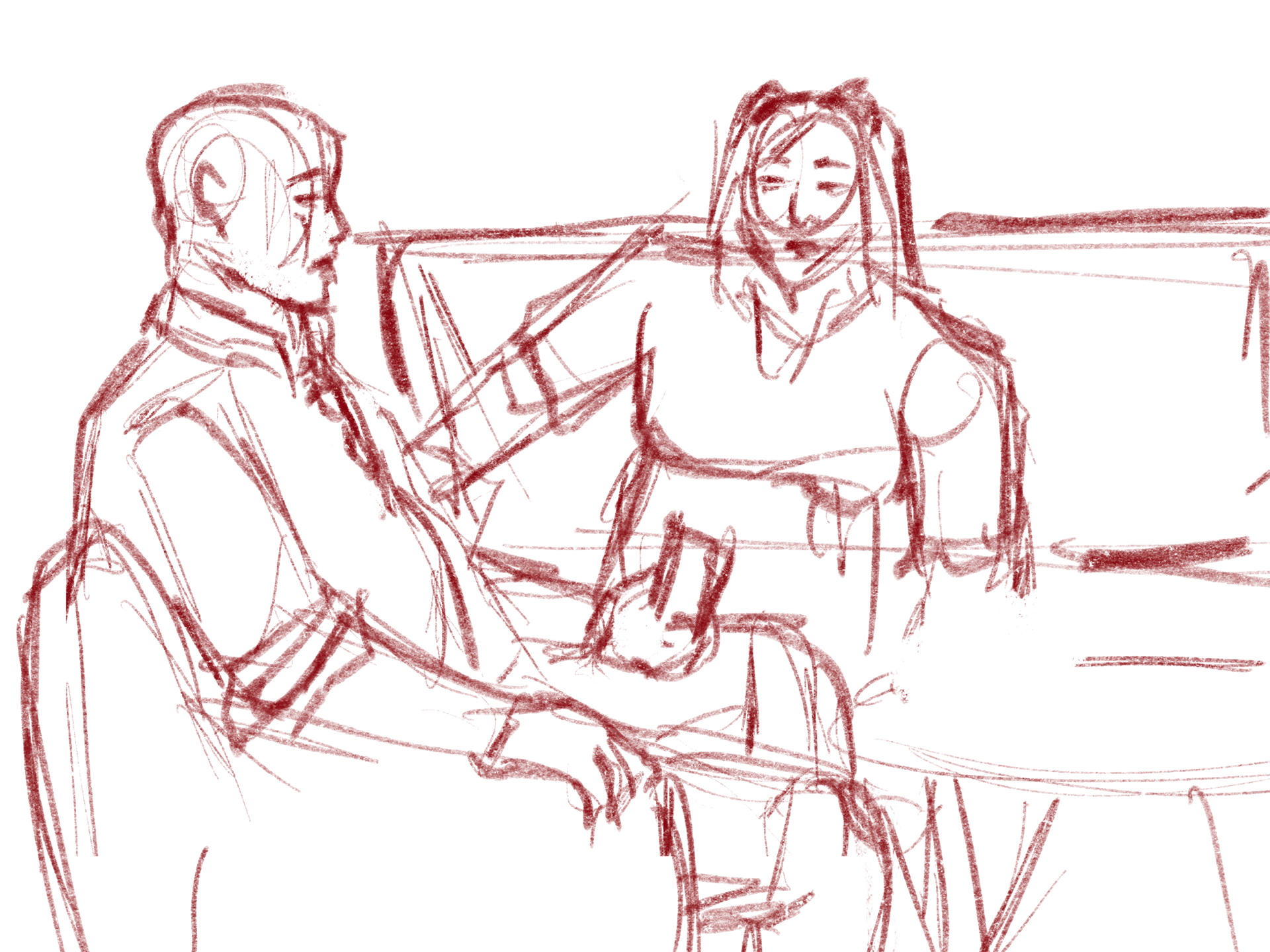

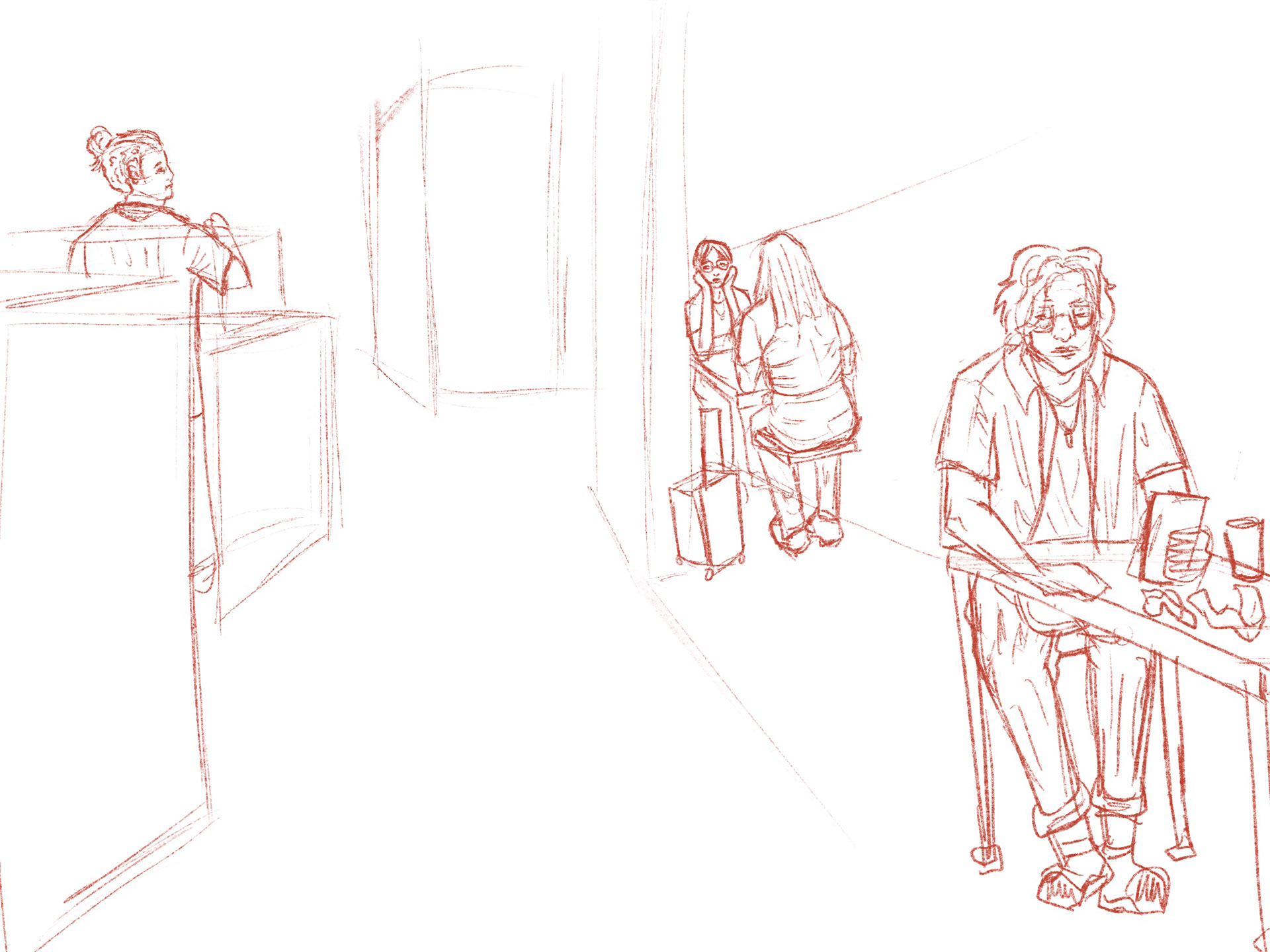

I began this project by focusing on what I enjoy most: observational drawing. I spent time in cafes, sketching as many people as I could. Naturally, most of the drawings remained unfinished because people moved before I could capture them fully. Since these micro-actions are so brief, I wasn’t able to draw them properly, but I did take the time to observe and study them. I avoid taking photos of people in public to respect their privacy and steer clear of potential issues.
After a feedback session with Kristian, I was encouraged to delve deeper into analyzing both my own motivations for this project and the reasons behind the unconscious actions people perform without realizing it. Following this advice, I continued documenting traits, creating more observational sketches, and reflecting on the patterns I was noticing.
Additionally, I began researching artists whose work aligns with my topic, seeking inspiration and insight into how they explore similar themes. This process helped me refine my approach and add more depth to my observations and artistic exploration.
As I continued, I started noticing patterns in the behaviors of those closer to me, such as my roommates and friends. I compiled a list of actions they often do, especially when they’re stressed, anxious, or excited. Knowing them so well allowed me to sketch these actions from memory, even without them being physically present. To refine my skills, I also did a series of quick sketches of them engaged in everyday, mundane activities.
At this stage, however, the research felt somewhat bland. To add depth, I began reflecting on 'why' they might perform these unconscious actions, making notes about the possible emotions or circumstances that might trigger them.
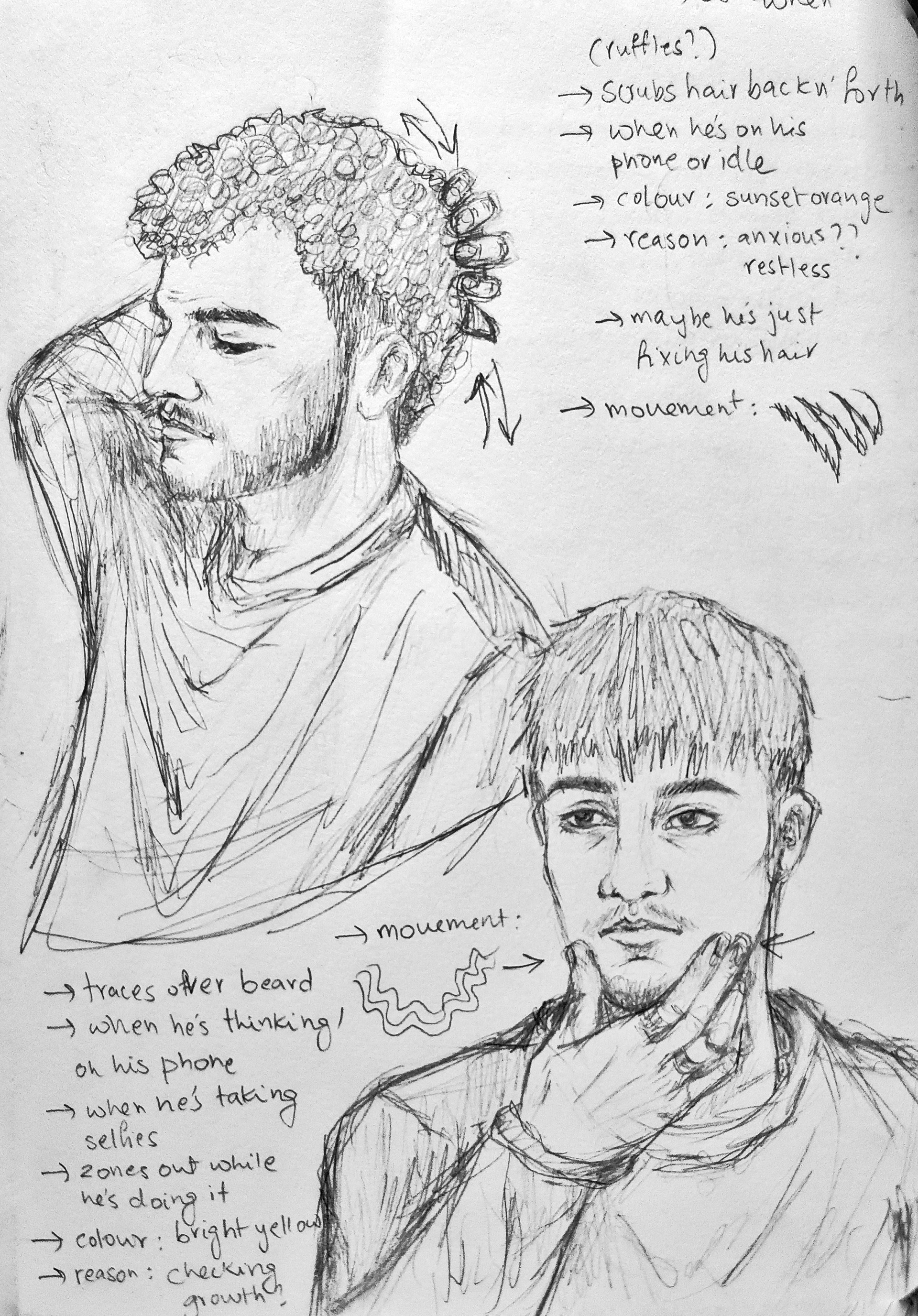

Shadow Box Idea
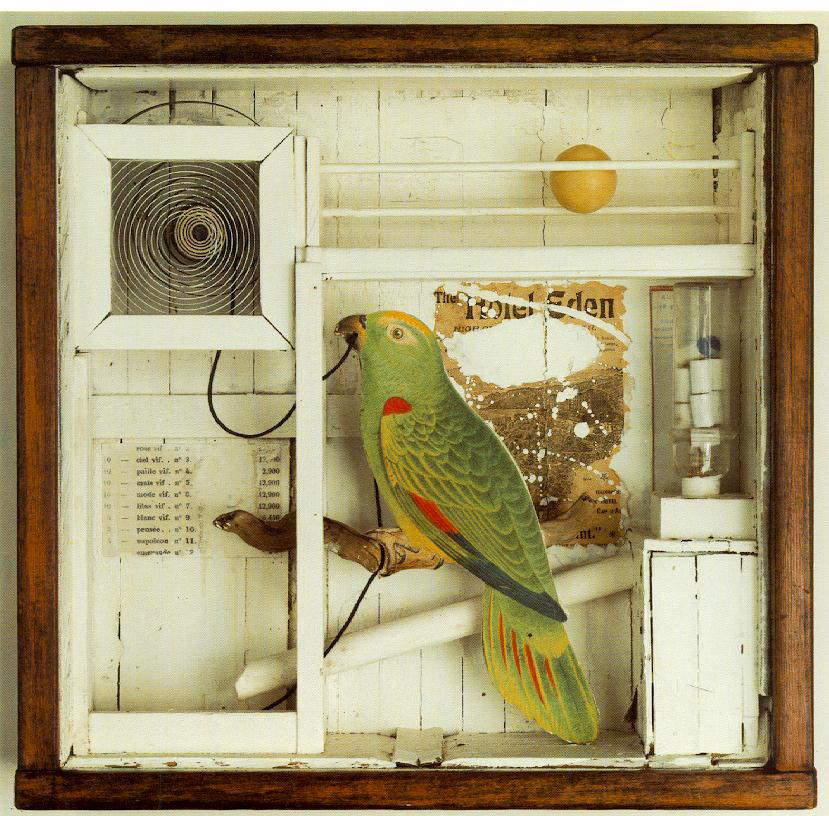


Joseph Cornell, an American contemporary artist, was known for his shadow boxes—small, glass-fronted enclosures filled with carefully arranged objects that evoke memory, nostalgia, and wonder. Inspired by themes like travel, astronomy, and dreams, Cornell transformed everyday items into symbolic narratives. His works feel like intimate, surreal worlds, inviting viewers to interpret their meaning.
I thought these shadow boxes resonate with themes of unconscious actions as well, as they reflect how we unintentionally collect and compartmentalize memories.
Sources:
Art in Context, 2023. Joseph Cornell and the Art of Assemblage: A Surreal Journey. [online] Available at: https://www.artincontext.org/joseph-cornell-shadow-boxes/ [Accessed 19 November 2024].
Royal Academy of Arts, 2023. Joseph Cornell: Pioneer of Assemblage Art. [online] Available at: https://www.royalacademy.org.uk/article/joseph-cornell-pioneer-of-assemblage-art [Accessed 19 November 2024].
I wanted to draw inspiration from Joseph Cornell's work, particularly his shadow boxes, to create a piece that embodies subconscious actions. My idea is to design a wall grid consisting of a large frame divided into smaller sections, with each frame showcasing a different micro-action. To stay true to Cornell’s process, I plan to use only scrap materials or found objects, which would give the work an authentic, personal touch. For example, if one section depicts an action like adjusting a shirt or tie, I might use fabric, buttons, or thread. Similarly, for actions like chewing or lip-biting, I’d incorporate items like pen caps, lipstick, or erasers. For movements like leg tapping or finger fidgeting, materials such as springs or sponge could be used to capture the sense of motion.
Additionally, I want to make the piece interactive. Before sealing it with glass, I plan to carve out small holes, allowing viewers to touch the materials inside or even manipulate some of the objects. The background will feature articles or texts that explore how these actions are often linked to psychological struggles, such as anxiety or body dysmorphia.
Crochet Wig Idea



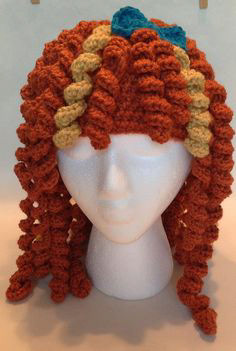
I came across a crochet wig on social media and found it both unique and intriguing. I wanted to adapt this idea for my project, so I imagined creating a hat or headpiece where, instead of hair growing from the scalp, a series of crocheted arms and hands would extend outward. I envisioned it having a slightly eerie vibe.
For materials, I decided the arms would be crocheted up to the wrists, while the hands would be made from something lightweight like papier-mâché. To make the fingers poseable, I’d use wire so they could bend into various positions to mimic different actions. My goal was for the piece to be interactive, like a model showing off an outfit. The idea would be to put this "wig" on and manipulate the arms to perform actions.
To achieve this, I planned to add hooks to bite onto in the palms of the hands, to enable mimicking actions such as holding the face, squeezing the nose, or touching the skin. I’d also add body tape to the fingers so they could easily stick to the face. I want to explore unconscious, self-soothing actions like skin picking, nose rubbing, eye scratching, and nail biting. This is still a new idea for me, and I'm not entirely sure how to execute it yet, especially since I don’t know how to crochet properly.


Theories and Phenomenon

Invisible String Theory
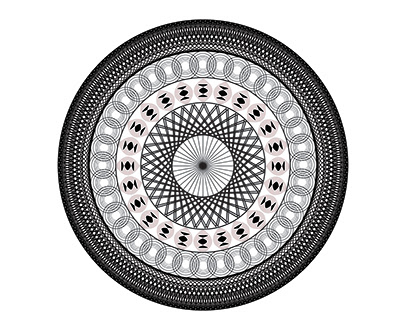
Mandela Effect

Evil Eye
I've been thinking a lot about string theory and the concept of invisible connections, and how it could tie into my project about belonging and the micro-actions I observe in people. In string theory, everything in the universe is made up of tiny, vibrating strings of energy, all interconnected, even though we can’t see those connections. It’s a really interesting idea because, in a way, it feels like the micro-actions I notice in people are like those invisible strings. Things like tapping a foot or adjusting their posture are small, subconscious movements, but they say so much about how we relate to our surroundings and to each other, even if we're unaware of them.
I think these unconscious actions represent those subtle vibrations that show how we connect with the world and the people around us. They’re these tiny, invisible threads that reflect a sense of belonging, even when we don’t overtly express it. Sometimes, we don’t even realize we’re making these movements, but they could be a sign of how we're navigating our space, looking for a place to fit in, or simply responding to our emotions in ways that others don’t always notice.
There’s also a conspiracy theory I came across called the "Mandela Effect," where large groups of people remember things differently or misremember events, creating a sense of alternate realities or parallel universes. While it’s not directly about belonging, it made me think about how we each perceive ourselves and others through these small actions. Our behaviors, even the ones that go unnoticed, might show us how we are navigating our own version of reality. And in a way, these subtle actions are part of how we communicate a sense of belonging, even if it feels distorted or unrecognized.
I’ve also been thinking about how the concept of the evil eye could tie into the project. The evil eye is a belief that a look, often driven by envy or jealousy, can cause harm or bad luck to someone. It's seen as an invisible force—one person’s gaze influencing the well-being of another. What’s intriguing is that this ties into something I’m exploring with my project: the idea of unseen forces that shape our experiences and actions, especially when it comes to micro-actions.
The evil eye also relates to how people adjust their behaviors in response to being "watched" or perceived, much like how some individuals might feel a sense of being scrutinized or judged in certain social situations. These micro-actions might be a defense mechanism or a way to align oneself with or distance oneself from others' energy, similar to how people might guard against the evil eye by wearing charms or amulets for protection.
In a way, these tiny movements could reflect not only personal, unconscious habits but also the subtle influence of social dynamics and the unspoken energy we exchange with others. It all ties back to the idea of belonging: how we fit into different spaces, how we’re affected by those around us—sometimes even without realizing it—and how these micro-actions reveal those connections or tensions.
I’m really drawn to the idea that these invisible connections—these micro-actions—are a way we connect with the world and the people around us, even if we don't consciously realize it.
Sources:
Invisible String Theory
Minds Journal, 2024. Invisible string theory explained: 7 ways to make it work. [online] Available at: https://themindsjournal.com/invisible-string-theory-explained/ [Accessed 19 November 2024].
Bustle, 2021. What is the invisible string theory? An explanation of the romantic concept. [online] Available at: https://www.bustle.com/articles/invisible-string-theory [Accessed 19 November 2024].
Minds Journal, 2024. Invisible string theory explained: 7 ways to make it work. [online] Available at: https://themindsjournal.com/invisible-string-theory-explained/ [Accessed 19 November 2024].
Bustle, 2021. What is the invisible string theory? An explanation of the romantic concept. [online] Available at: https://www.bustle.com/articles/invisible-string-theory [Accessed 19 November 2024].
Mandela Effect
Baptista, M., 2023. The Mandela Effect: The psychological phenomenon behind collective false memories. Psychology Today. [online] Available at: https://www.psychologytoday.com/articles/the-mandela-effect [Accessed 19 November 2024].
Baptista, M., 2023. The Mandela Effect: The psychological phenomenon behind collective false memories. Psychology Today. [online] Available at: https://www.psychologytoday.com/articles/the-mandela-effect [Accessed 19 November 2024].
Evil Eye Theory
Eliade, M., 2019. The Evil Eye: A Cultural History. Routledge, London.
Parsons, R., 2021. The Evil Eye and its Influence: An Exploration of Cultural Beliefs. Anthropological Studies Journal, 45(2), pp. 102-115.
Eliade, M., 2019. The Evil Eye: A Cultural History. Routledge, London.
Parsons, R., 2021. The Evil Eye and its Influence: An Exploration of Cultural Beliefs. Anthropological Studies Journal, 45(2), pp. 102-115.
Dream Catcher Idea

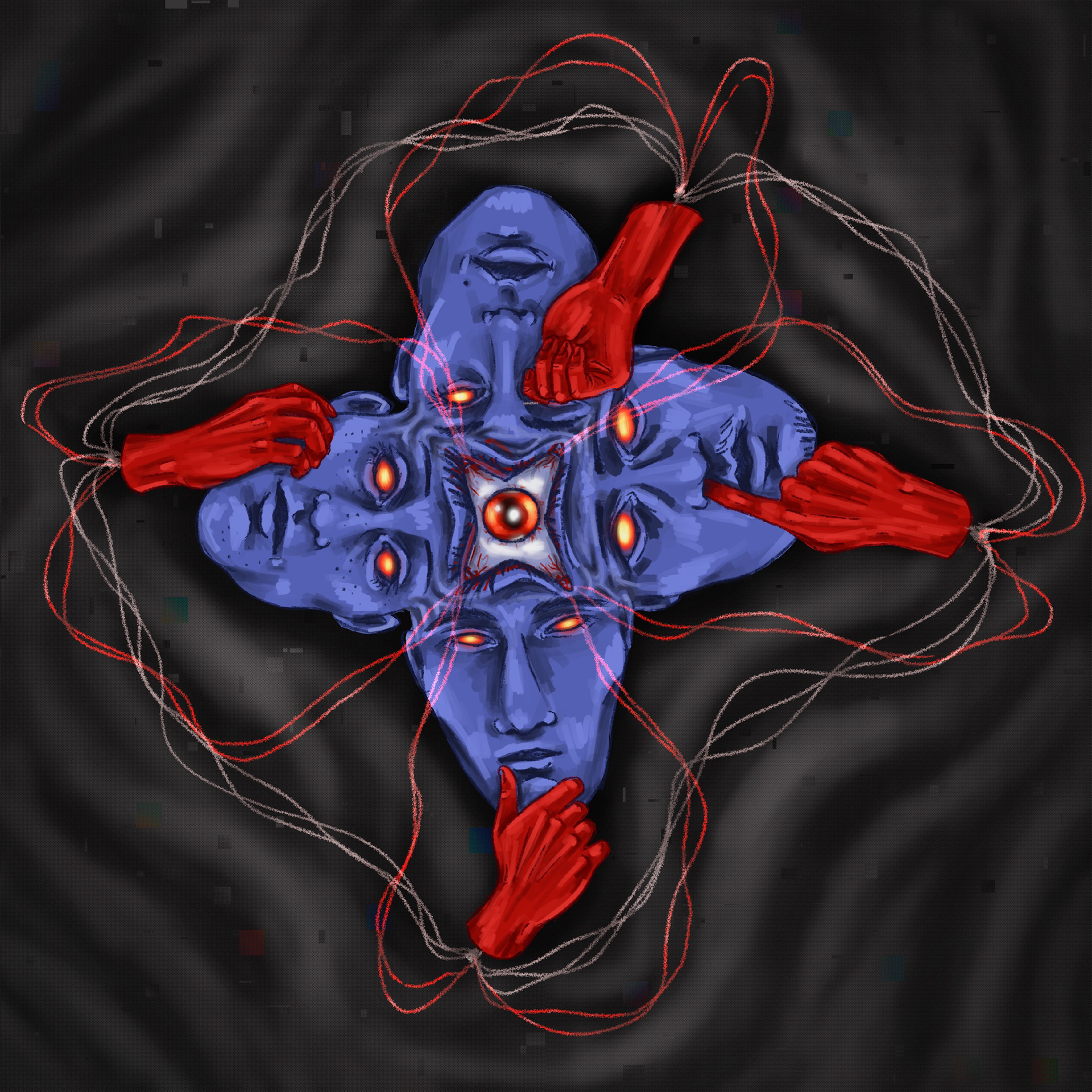
This idea initially started out as a simple observational sketch where I was drawing random people engaging in unconscious actions like skin picking, lip touching, or other subtle gestures. I decided to combine them into a single illustration, creating a figure composed of several faces, all performing these actions mindlessly. To enhance the sense of being "absent minded," I removed the pupils from the eyes, making the faces appear like drones, as though something—or someone—was observing or directing them. The central eye, in particular, gave the impression that it was perceiving the actions of the faces around it.
Interestingly, I later realized that the structure of these faces resembled the form of a dreamcatcher. I thought of transforming this idea into a hyper-realistic, unsettling dreamcatcher, with body parts like noses, lips, and eyes hanging from it, symbolizing the unconscious and often disturbing actions that humans perform without realizing it. To tie this concept into my exploration of subconscious behavior, I thought about integrating the ideas of string theory and the Evil Eye, where unseen connections or forces (like invisible strings) link people and their unconscious actions, while the Evil Eye symbolizes the idea of unseen observation over one's actions.
Rauschenberg Combine

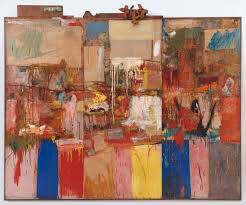

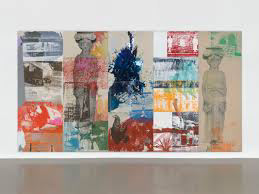

Robert Rauschenberg’s Combines were a blend of painting and sculpture, mixing found objects, paintings, and even materials like dirt or fabric into a single work. He created confusion and chaos by incorporating elements that didn’t traditionally belong together. This made his pieces both visually jarring and intriguing, challenging the viewer to make sense of it all. His work embodied a kind of fragmented reality—like a collage of disparate thoughts, memories, and objects that told a story not through coherence, but through the tension between them
What I love about his Combines is how they mirror the unpredictability of human behavior. Just as his pieces are full of seemingly random elements, I’m exploring how subconscious actions and habits are just as unpredictable and scattered. For my project, I want to use collage in a similar way, bringing together bits and pieces of actions—things people do without thinking, like skin picking, lip biting, or hair twirling—and combining them into a single image that feels as chaotic and complex as the unconscious mind itself. In doing so, I hope to create confusion in my work, much like Rauschenberg, so that the viewer is forced to confront these seemingly disconnected actions and try to understand the larger meaning behind them.
Rauschenberg also played with myth and symbolism in his Combines. This is where I can link it to the themes of the Evil Eye or string theory that I've been considering. Just like the mythological elements Rauschenberg included in his work, I want to explore how the unseen forces—like the subconscious mind or external societal pressures—shape these micro-actions.
I want to break away from traditional frames and create something more three-dimensional, using cardboard and board mounts. On one side of the model, I’ll create a self-portrait where I’m pulling out one of my eyes, as if it’s being removed. The eye will be positioned to face the wall through a keyhole. Behind the keyhole, I’ll place a triangular-shaped board mount, creating a sense of depth. This mount will feature a chaotic collage of the unconscious actions I’ve observed in my friends, with each action connected by string to the eye through the keyhole. I want to give the illusion that I’m seeing these actions through the keyhole—quietly observing without them realizing it, much like how we observe unconscious behaviors in others without them knowing.
I plan to support the piece with a frame stand and place a piece of floor in front of the collage. The floor will be decorated with more Evil Eye symbols. The idea is to make the viewer feel like they are peeking into a world of subconscious actions, where they too are becoming an observer, much like the Evil Eye and string theory that I’m exploring. I want to bring together the chaotic, interconnected nature of subconscious actions, the power of unseen observation, and the unsettling feeling that comes with being watched without knowing it.
For the color scheme of my piece, I've been inspired by the vibrant and contrasting palette used by Grayson Perry, which we saw in the Lakeside Arts gallery back in September. I was drawn to the intricate details in his work and how he balances such bold, contrasting colors while maintaining a sense of harmony. I want to incorporate that vibrancy into my own work. Perry’s use of bright hues to draw attention to particular elements within his work resonated with me, and I hope to use similar methods to create visual focal points in my 'Combine'.
I also found myself influenced by the semi-realisism sketches of Paula Rego. When we visited the gallery, I became captivated by her ability to blend figurative work with surreal elements, creating scenes that are simultaneously relatable and unsettling. To experiment with this, I created a collage using various characters and creatures from her drawings. I placed them together on a single page, combining them in a way that reflected the kind of collage I envision for the project. I want to blend the surreal and the familiar, much like Rego does, where the viewer is drawn into a world that feels both real and dreamlike at the same time. This approach will help guide the aesthetic direction of my piece, ensuring that the chaotic elements of the collage are balanced and visually engaging.
A Shift in Attitude
That desire to create stories that disturb the comfortable and comfort the disturbed is what led me back to myself, not just as an artist, but as someone learning to live with and understand Borderline Personality Disorder. The more I leaned into the emotional truths of my condition, the more my work began to shift. I no longer felt the need to protect my audience from the messiness of my experience, or to hide behind humour as a deflection. Instead, I let the instability show. I allowed the work to be fragmented, raw, contradictory because that is what living with BPD often feels like.
This shift in mindset began to shape the entire structure of my project. Rather than chasing stylistic consistency, I started embracing variation. It became clear that the inconsistency in my mark-making, materials, and visual language was not a weakness. It was a mirror. A mirror to the fractured way I relate to identity, the emotional intensity I try to regulate, and the way I often collect bits and pieces of others in an attempt to define myself. The project stopped being about presenting something polished and started becoming a space where I could simply exist as I am; fluctuating, searching, overwhelmed, but honest.
Because of Borderline Personality Disorder, I mirror and idealise others in order to feel connected. I become highly attuned to small, unconscious gestures such as leg bouncing, pen twirling, or spontaneous smiles, and use these details to construct a version of myself. My personality often feels less like something innate and more like a collage of the people I observe. While I forget major events and timelines, these fleeting behaviours stay with me. They represent both my longing for authenticity and my attempt to belong by borrowing pieces of others.
At the start of my degree, I rarely felt comfortable speaking openly about this. I worried about how I would be perceived, too personal, too self-indulgent, too messy. But over time, my perspective shifted. Instead of avoiding these parts of myself, I began seeing them as valid and worthy of expression. I stopped treating vulnerability as a liability and started using it as a framework for creative exploration. That change in mindset allowed me to be more honest, both in my work and with myself.
In this project, the act of mirroring becomes the core theme. It is not just a psychological coping mechanism, it becomes an artistic process. These observations are no longer passive curiosities but emotional artifacts. They serve as building blocks, fragments I quietly collect to shape a version of self I can recognise. Through a series of illustrations, I explore unconscious gestures people make without realising, small physical actions like adjusting clothing, fidgeting, or zoning out. These subtle movements, often overlooked, become entry points into larger questions about identity, connection, and the fluid self.
The project invites viewers to reflect on the parts of themselves they have absorbed from others, the gestures they have inherited, the expressions they mimic without knowing. It is as much about understanding others as it is about understanding myself. In visualising these tiny, human details, I am not just documenting behavior, I am tracing the edges of a shifting identity that exists somewhere between observation and embodiment.
Everyone I Ever Was
For the final piece, I am creating a book that illustrates a collection of unconscious gestures, small, unnoticed movements people make without realising. Each page focuses on a single action, captured through observational drawing and paired with short pieces of text or poetry. I want the book to feel vivid and emotionally charged, so I am using a bright, complementary colour palette with strong contrasts. Shades of red, blue, and purple dominate the pages, creating visual intensity that mirrors how these subtle behaviours feel to me, quiet yet deeply affecting. The book follows a loose narrative. It begins with a version of myself that feels incomplete, fragmented, and assembled from others. As the pages unfold, I begin stitching these gestures into a more cohesive sense of self. But even at the end, I do not seek full resolution. Instead, I aim to stay honest about the ambiguity that comes with constructing identity through observation. The accompanying text has been difficult to get right. I want the words to feel poetic and intentional, not like add-ons. I explored different styles of writing, some with rhyme, some without, until I found a rhythm that complemented the imagery without overpowering it.
At first, I found it hard to choose which gestures to illustrate. I explored a wide range of movements such as hair twirling, nail biting, zoning out, and tugging on sleeves, and eventually selected the ones that felt most emotionally resonant. Once I understood why I was drawn to each gesture and what I wanted to communicate through them, the work began to flow more naturally. The process became faster and more fulfilling once I was honest with myself about the emotional core of the project. I sourced reference material from various online sites, combining them with my own sketches and memories. The background settings were another area of experimentation. I did not want the pages to feel flat or too polished, so I used gelli prints to add rich texture and variation. I kept layering, cutting, and rebuilding until the backgrounds felt like they carried as much emotional weight as the figures themselves.
I initially struggled with maintaining a consistent art style, feeling the pressure to create something cohesive. But over time, I began to see the shifts in style as a strength. The inconsistency mirrors the fragmented, fluid nature of identity I am trying to explore. Letting go of the need to stick to a style made the project feel less like a performance and more like a conversation with myself, with the audience, and with the images themselves.




















Text and Poetry
Some other text drafts I was considering before the final.
-
“I watched from the middle of everything—blurred, undefined.
They all seemed real.
I was just passing through, trying not to be seen.”
They all seemed real.
I was just passing through, trying not to be seen.”
“They didn’t know I was watching.
But I saw the tiny things.
The way they moved when no one was looking.
Those were the parts I wanted most.”
But I saw the tiny things.
The way they moved when no one was looking.
Those were the parts I wanted most.”
“She danced like she didn’t need permission.
I wrote her rhythm into my bones.
Maybe if I moved like her, I’d feel like I belonged too.”
I wrote her rhythm into my bones.
Maybe if I moved like her, I’d feel like I belonged too.”
“A nervous habit, a secret language.
She bit her lip when words failed—
so I did too,
hoping the silence would feel less lonely.”
She bit her lip when words failed—
so I did too,
hoping the silence would feel less lonely.”
“He pulled the strings tighter,
like he could shrink into safety.
I copied him,
trying to hide inside someone else’s comfort.”
like he could shrink into safety.
I copied him,
trying to hide inside someone else’s comfort.”
“She twirled her hair into tiny storms.
I thought, maybe if I did it right,
I could twist myself into something soft too.”
I thought, maybe if I did it right,
I could twist myself into something soft too.”
“He stared into nothing,
and somehow it looked like peace.
I let my mind drift beside his—
trying to float in someone else’s quiet.”
and somehow it looked like peace.
I let my mind drift beside his—
trying to float in someone else’s quiet.”
“She knew how to shape her face
into someone the world would love.
I studied her brushstrokes
like they were scripture.”
into someone the world would love.
I studied her brushstrokes
like they were scripture.”
“They burned, they sipped, they laughed.
I followed the script.
Hoping if I played the part right,
I’d be cast in the story too.”
I followed the script.
Hoping if I played the part right,
I’d be cast in the story too.”
“She combed through the knots gently,
as if caring was a language.
I tried to learn it—
but my hands were too rough.”
as if caring was a language.
I tried to learn it—
but my hands were too rough.”
“I saw someone press too hard.
I did it too.
Peeling at flaws like they were stickers
I couldn’t stop picking at.”
I did it too.
Peeling at flaws like they were stickers
I couldn’t stop picking at.”
“Their fingers danced nervously—
fluttering, tugging, tapping.
I memorized every move.
Maybe I could fidget my way into feeling something real.”
fluttering, tugging, tapping.
I memorized every move.
Maybe I could fidget my way into feeling something real.”
“She slept through the morning light.
I watched her breathe deeply,
and thought:
Maybe rest is rebellion.”
I watched her breathe deeply,
and thought:
Maybe rest is rebellion.”
“He chewed the edges of his nerves.
I tasted the habit,
let it settle between my teeth—
a borrowed anxiety.”
I tasted the habit,
let it settle between my teeth—
a borrowed anxiety.”
“She spoke about dreams like they were facts.
I wrote down every word,
hoping one day I’d find a future
that felt like mine too.”
I wrote down every word,
hoping one day I’d find a future
that felt like mine too.”
“I became a quiet scholar.
Collected gestures like pressed flowers.
Each one a clue—
a hint of what it means to be whole.”
Collected gestures like pressed flowers.
Each one a clue—
a hint of what it means to be whole.”
“I dipped my brush into other people.
Outlined their joys, shaded in their fears.
Painted them over myself—
until I didn’t know where I ended.”
Outlined their joys, shaded in their fears.
Painted them over myself—
until I didn’t know where I ended.”
“I thought I was empty.
But when I opened myself,
they poured out—
all the borrowed pieces I tried to call mine.
A crowd stitched into one skin.”
But when I opened myself,
they poured out—
all the borrowed pieces I tried to call mine.
A crowd stitched into one skin.”
_
I was there,
but only just.
Blended into background noise,
while everyone else moved with purpose.
but only just.
Blended into background noise,
while everyone else moved with purpose.
So I watched—
not out of curiosity,
but out of hunger.
They didn’t know I was learning them,
one gesture at a time.
not out of curiosity,
but out of hunger.
They didn’t know I was learning them,
one gesture at a time.
She danced like she was made of music.
No hesitation.
No asking to exist.
I followed the rhythm,
pretending I belonged inside the beat.
No hesitation.
No asking to exist.
I followed the rhythm,
pretending I belonged inside the beat.
He bit his lip like he was holding in thoughts
too sharp to speak.
I mirrored him.
It felt like a way to be mysterious
without saying anything at all.
too sharp to speak.
I mirrored him.
It felt like a way to be mysterious
without saying anything at all.
She tugged the strings tighter,
like they were armor.
So I did too.
Wrapped myself in someone else’s shield,
hoping it would hold me in place.
like they were armor.
So I did too.
Wrapped myself in someone else’s shield,
hoping it would hold me in place.
Fingers twisted through strands—
careless, soft.
I copied the motion,
thinking maybe I’d untangle something
deep inside myself.
careless, soft.
I copied the motion,
thinking maybe I’d untangle something
deep inside myself.
His gaze floated beyond the window,
where nothing asked anything of him.
I drifted beside it,
grateful for the stillness borrowed from another mind.
where nothing asked anything of him.
I drifted beside it,
grateful for the stillness borrowed from another mind.
She painted herself beautifully,
like every brushstroke could rewrite the day.
I watched closely.
Tried to follow her map to mattering.
like every brushstroke could rewrite the day.
I watched closely.
Tried to follow her map to mattering.
They burned and swallowed and laughed,
and I did too.
Thinking maybe
if I drank what they drank,
I’d feel what they felt.
and I did too.
Thinking maybe
if I drank what they drank,
I’d feel what they felt.
She combed gently,
like softness was second nature.
I mimicked the ritual,
but my touch always snagged.
like softness was second nature.
I mimicked the ritual,
but my touch always snagged.
Some picked at their skin
like they were trying to surface.
I did it too.
Anything to feel real.
like they were trying to surface.
I did it too.
Anything to feel real.
Their hands always moved—
tapping, wringing, searching.
So I let mine fidget.
Felt less alone in the echo.
tapping, wringing, searching.
So I let mine fidget.
Felt less alone in the echo.
She slept late,
like she trusted the world to wait.
I envied her peace,
then curled into it quietly,
hoping it might be contagious.
like she trusted the world to wait.
I envied her peace,
then curled into it quietly,
hoping it might be contagious.
He bit until his thoughts quieted.
I bit until mine bled.
We both needed something to chew on.
I bit until mine bled.
We both needed something to chew on.
She spoke of dreams
with bright eyes and clenched fists.
I clung to her voice
like it could carry me forward.
with bright eyes and clenched fists.
I clung to her voice
like it could carry me forward.
I wasn’t just watching anymore—
I was compiling.
Classifying.
Curating other people’s essence,
as if it could fill my own.
I was compiling.
Classifying.
Curating other people’s essence,
as if it could fill my own.
Every gesture I stole
became another brushstroke
in a portrait I didn’t recognise.
I kept painting anyway.
became another brushstroke
in a portrait I didn’t recognise.
I kept painting anyway.
When I finally opened myself,
I expected emptiness.
Instead—
a flood.
All the borrowed pieces
tumbled out.
I was never just one person.
I was everyone I ever tried to be.
I expected emptiness.
Instead—
a flood.
All the borrowed pieces
tumbled out.
I was never just one person.
I was everyone I ever tried to be.
_
I existed as a blur.
No edges, no volume.
Just a shadow between the real people,
practicing presence without permission.
No edges, no volume.
Just a shadow between the real people,
practicing presence without permission.
So I watched.
Carefully. Obsessively.
Not because I was curious—
because I was hollow,
and they were full.
Carefully. Obsessively.
Not because I was curious—
because I was hollow,
and they were full.
She moved like she owned every room.
I studied her spine,
her rhythm, her certainty.
I memorised it.
Wore it like a mask made of music.
I studied her spine,
her rhythm, her certainty.
I memorised it.
Wore it like a mask made of music.
He bit his lip when the silence got loud.
So did I.
Not because I was nervous—
but because my thoughts
were clawing to get out.
So did I.
Not because I was nervous—
but because my thoughts
were clawing to get out.
She pulled her hoodie tighter
like it could keep her from falling apart.
I copied that gesture too—
hoping the fabric would hold me
when I couldn’t hold myself.
like it could keep her from falling apart.
I copied that gesture too—
hoping the fabric would hold me
when I couldn’t hold myself.
She twirled her hair like she wasn’t even thinking.
But I was thinking.
Twisting, spinning,
trying to tie myself to something that made sense.
But I was thinking.
Twisting, spinning,
trying to tie myself to something that made sense.
He left the room without moving.
Eyes open, mind gone.
I followed.
Disappearing in broad daylight felt like magic.
Eyes open, mind gone.
I followed.
Disappearing in broad daylight felt like magic.
She carved out a version of herself
that the world would love.
I tried to copy her brushstrokes,
but the colours looked wrong on me.
that the world would love.
I tried to copy her brushstrokes,
but the colours looked wrong on me.
They laughed around lighters and bottles.
I joined in.
Burned my lungs, blurred my thoughts—
just to be let in,
even if I wasn’t really there.
I joined in.
Burned my lungs, blurred my thoughts—
just to be let in,
even if I wasn’t really there.
She brushed her hair like it was no big deal.
Like care was natural.
I tried.
But every stroke felt like a lie I hadn’t earned.
Like care was natural.
I tried.
But every stroke felt like a lie I hadn’t earned.
She picked at her skin like it betrayed her.
So did I.
Digging for flaws.
Tearing at the surface
hoping something underneath would feel true.
So did I.
Digging for flaws.
Tearing at the surface
hoping something underneath would feel true.
Their hands couldn’t stay still.
Neither could mine.
I wrung my fingers raw
because stillness made me visible,
and I wasn’t ready for that.
Neither could mine.
I wrung my fingers raw
because stillness made me visible,
and I wasn’t ready for that.
She slept while the world spun past.
I watched her chest rise and fall,
and thought—
maybe if I stayed still long enough,
everything painful might just forget me.
I watched her chest rise and fall,
and thought—
maybe if I stayed still long enough,
everything painful might just forget me.
He chewed like he needed to disappear.
I followed him into that ache.
Bit until I bled.
Until the pain was louder than the panic.
I followed him into that ache.
Bit until I bled.
Until the pain was louder than the panic.
She spoke about the future like it was hers.
I listened like a thief.
Pocketed her dreams, rehearsed her confidence.
Tried to wear it without cracking.
I listened like a thief.
Pocketed her dreams, rehearsed her confidence.
Tried to wear it without cracking.
I wasn’t just observing—
I was collecting.
Cataloguing every unconscious motion
like they were puzzle pieces
for a person I might become.
I was collecting.
Cataloguing every unconscious motion
like they were puzzle pieces
for a person I might become.
I layered their habits onto my skin.
Smoothed their thoughts into my posture.
Painted over myself again and again,
until there was no blank space left.
Smoothed their thoughts into my posture.
Painted over myself again and again,
until there was no blank space left.
And when I finally split open,
they poured out.
All the girls I tried to be.
All the boys I copied.
All the versions I wore to survive.
None of them were me.
But without them—
there would’ve been nothing.
they poured out.
All the girls I tried to be.
All the boys I copied.
All the versions I wore to survive.
None of them were me.
But without them—
there would’ve been nothing.
_
I was there, but barely so—
a ghost in denim, soft and slow.
They moved with shape and sound and name.
I just mimicked. Played the game.
a ghost in denim, soft and slow.
They moved with shape and sound and name.
I just mimicked. Played the game.
I watched them bloom in passing light,
while I stayed folded out of sight.
They lived so loud without a clue—
and I kept notes on what they’d do.
while I stayed folded out of sight.
They lived so loud without a clue—
and I kept notes on what they’d do.
She danced like gravity obeyed.
I traced her steps, then did the same.
I wore her rhythm like perfume,
just to be noticed in the room.
I traced her steps, then did the same.
I wore her rhythm like perfume,
just to be noticed in the room.
He bit his lip like thoughts might leak.
So I did too—afraid to speak.
My mouth was full of things unsaid,
so I gnawed the silence down instead.
So I did too—afraid to speak.
My mouth was full of things unsaid,
so I gnawed the silence down instead.
She pulled her hoodie, snug and tight,
like cloth could shield her from the night.
I mimed the motion, kept it near—
a second skin against the fear.
like cloth could shield her from the night.
I mimed the motion, kept it near—
a second skin against the fear.
She twirled her hair and seemed at ease,
like tension melted on the breeze.
I wrapped my fingers through my strands,
and tied my longing in a band.
like tension melted on the breeze.
I wrapped my fingers through my strands,
and tied my longing in a band.
He drifted off but didn’t move—
his stare was soft, his breath was smooth.
So I let go and slipped inside,
into a stillness I could hide.
his stare was soft, his breath was smooth.
So I let go and slipped inside,
into a stillness I could hide.
She painted warmth across her skin,
like love was something drawn within.
I copied blush and learned her face,
but couldn’t find my resting place.
like love was something drawn within.
I copied blush and learned her face,
but couldn’t find my resting place.
They smoked and laughed and passed the flame.
I lit up too. I played the same.
I drank the mask, I wore the dare—
pretended I belonged somewhere.
I lit up too. I played the same.
I drank the mask, I wore the dare—
pretended I belonged somewhere.
She brushed with care, with gentle grace,
like touch was made for soft embrace.
I tried to smooth the snarls away—
but pulled too hard. It wouldn’t stay.
like touch was made for soft embrace.
I tried to smooth the snarls away—
but pulled too hard. It wouldn’t stay.
She picked her skin like peeling paint.
I followed—patient, raw, and faint.
I scratched and scraped until it stung—
a ritual for coming undone.
I followed—patient, raw, and faint.
I scratched and scraped until it stung—
a ritual for coming undone.
Her fingers fluttered, restless, wild—
like panic dressed up as a child.
I joined the dance of twitch and twist,
afraid of stillness and its fist.
like panic dressed up as a child.
I joined the dance of twitch and twist,
afraid of stillness and its fist.
She slept like time was hers to bend.
I watched her body rise, descend.
So I curled up and stayed in bed,
pretending I was safe instead.
I watched her body rise, descend.
So I curled up and stayed in bed,
pretending I was safe instead.
He bit until his edges blurred.
So I bit too—without a word.
I chewed my worry down to bone,
until the ache became my own.
So I bit too—without a word.
I chewed my worry down to bone,
until the ache became my own.
She spoke of futures gold and far,
as if her wishes shaped the stars.
I memorized her every line—
as if her dreams could pass for mine.
as if her wishes shaped the stars.
I memorized her every line—
as if her dreams could pass for mine.
I watched. I wrote. I tried to claim
the hidden sparks behind each name.
A million moments in a jar—
none of them mine, but all so far.
the hidden sparks behind each name.
A million moments in a jar—
none of them mine, but all so far.
I stole their colors, soft and bright,
and painted through the hollow night.
I layered them across my skin—
hoping I’d find someone within.
and painted through the hollow night.
I layered them across my skin—
hoping I’d find someone within.
I unzipped slow and held my breath—
expecting silence, maybe death.
But out they spilled—each borrowed part,
a patchwork made of stolen art.
I watched them go. I let them free.
What’s left is what's becoming me.
expecting silence, maybe death.
But out they spilled—each borrowed part,
a patchwork made of stolen art.
I watched them go. I let them free.
What’s left is what's becoming me.
The Final Pages and Text


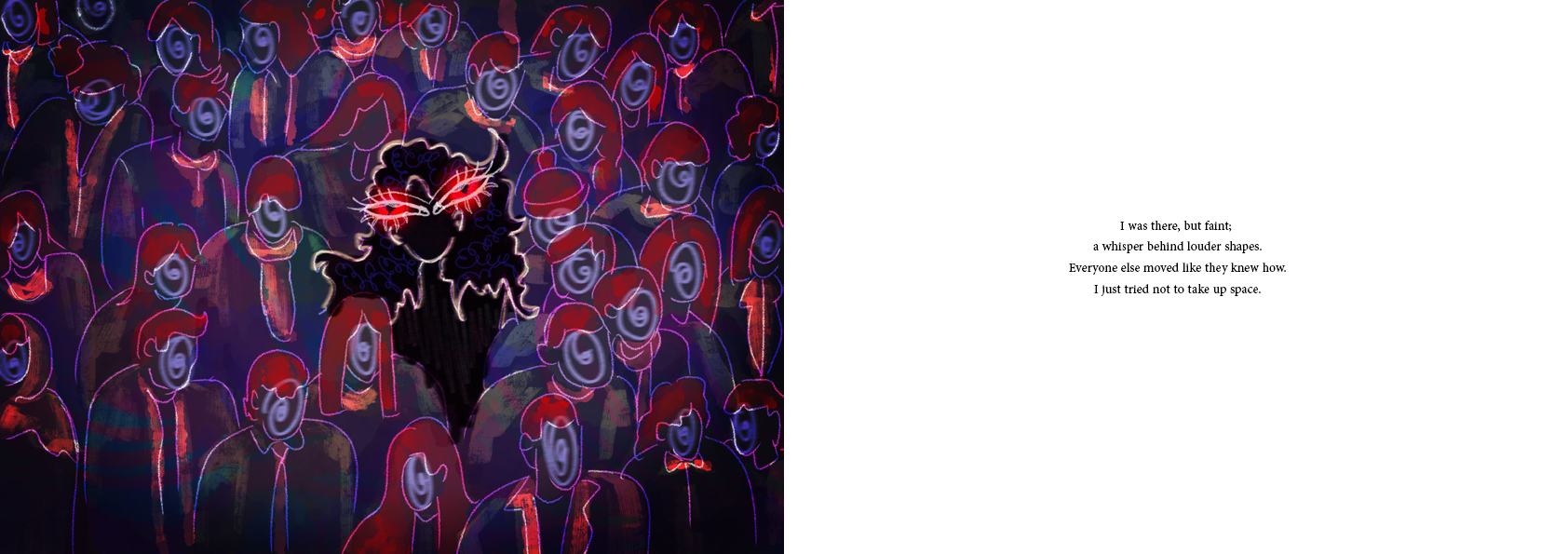




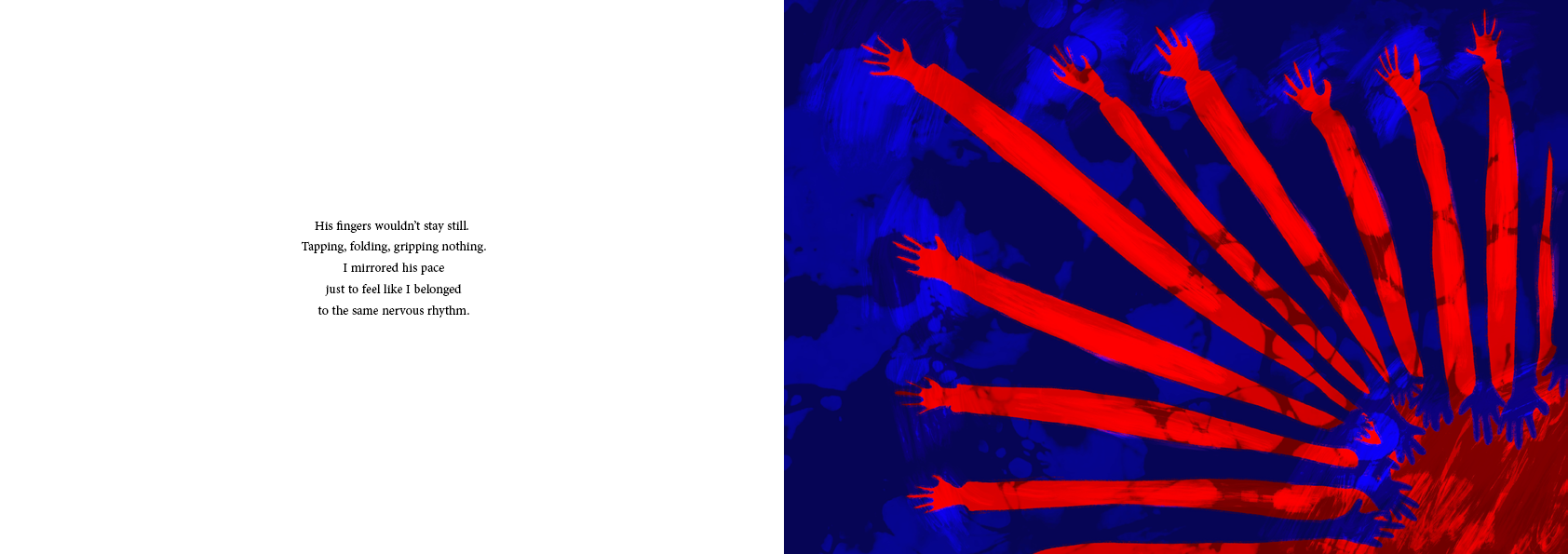
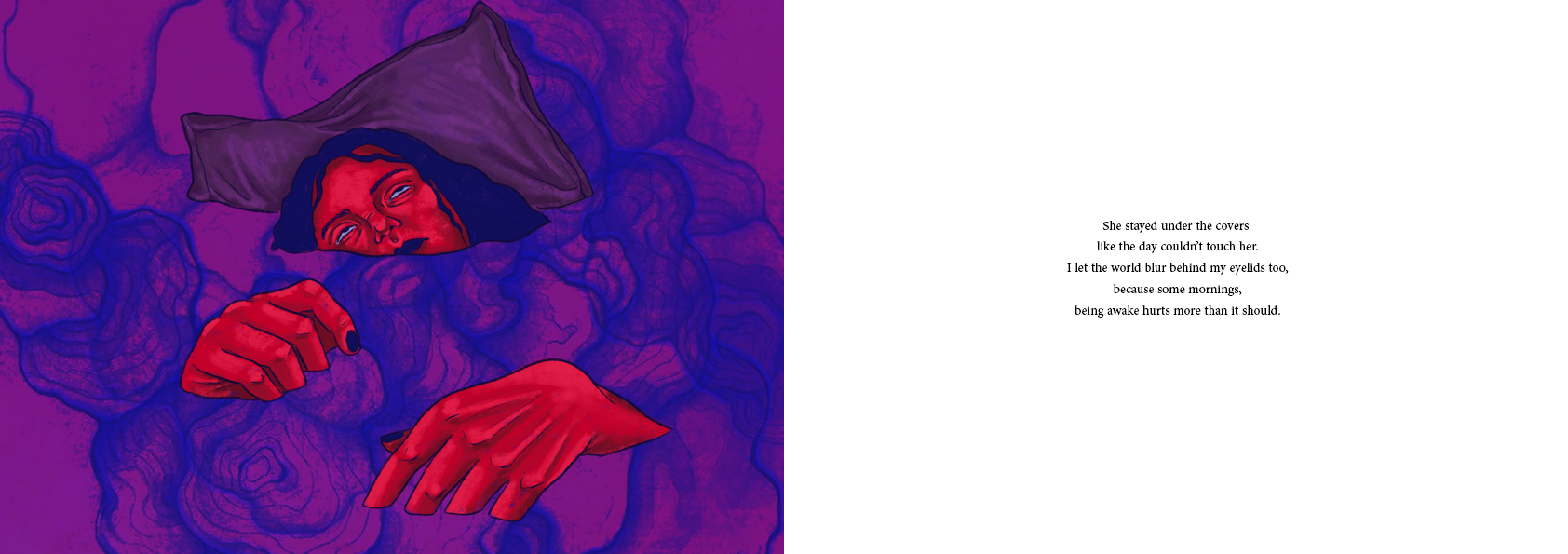
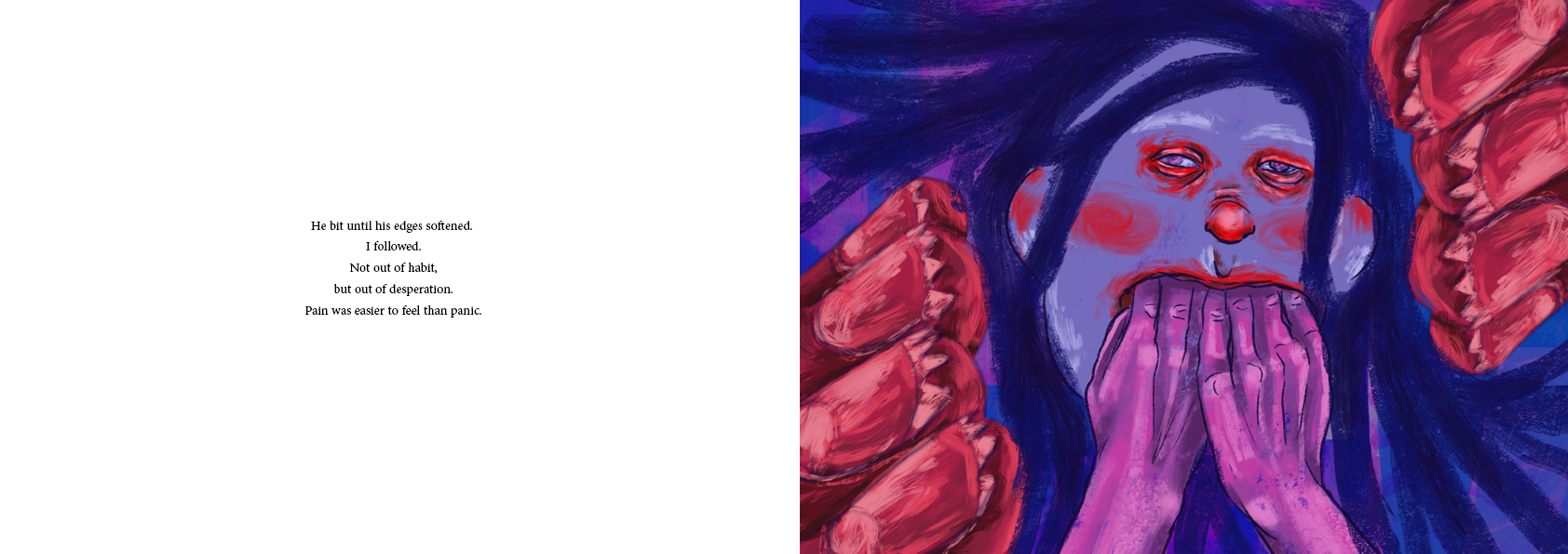
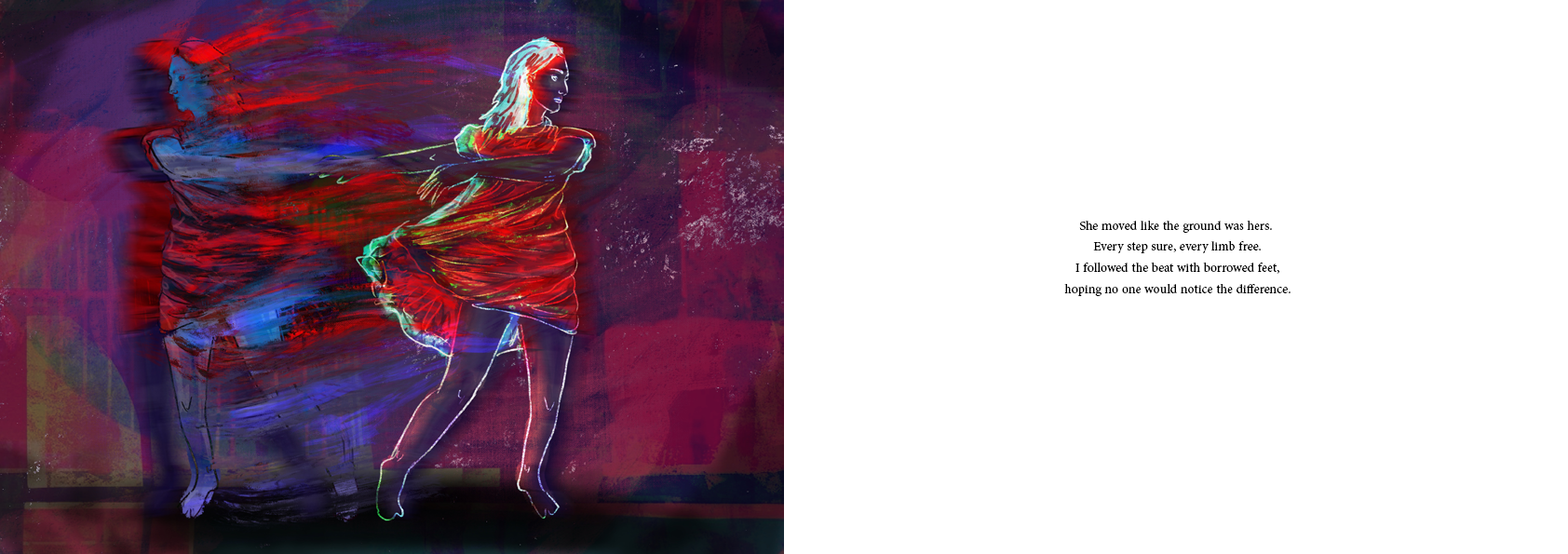
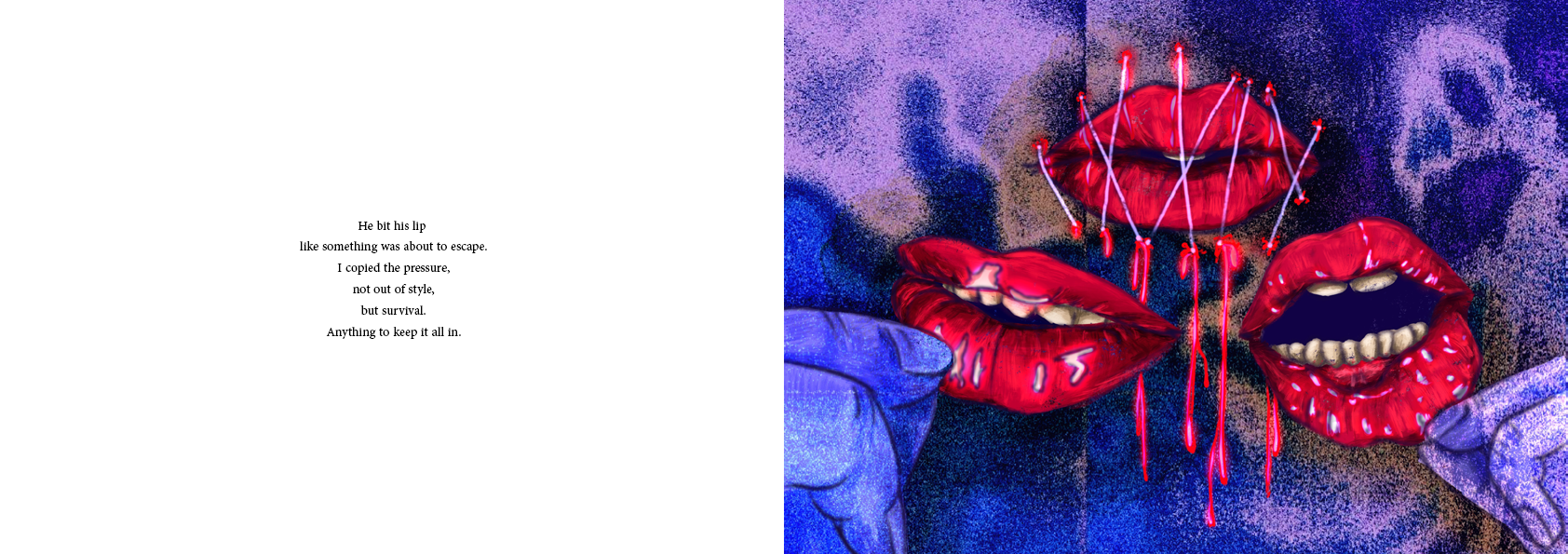
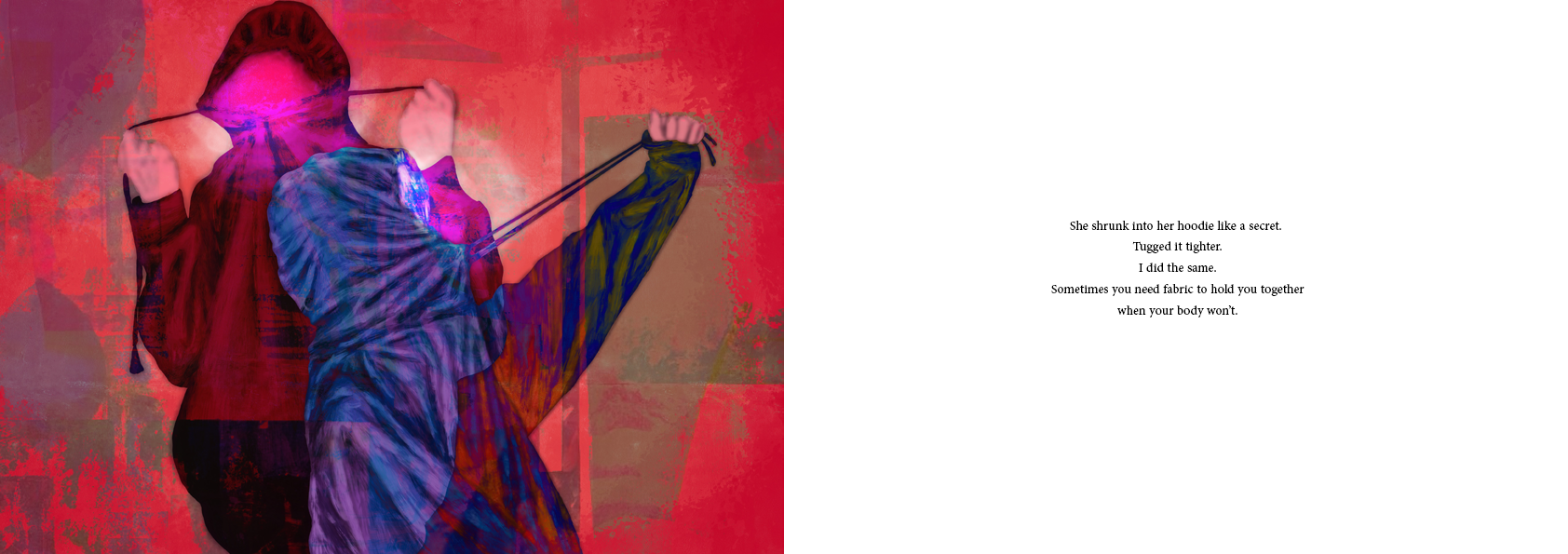


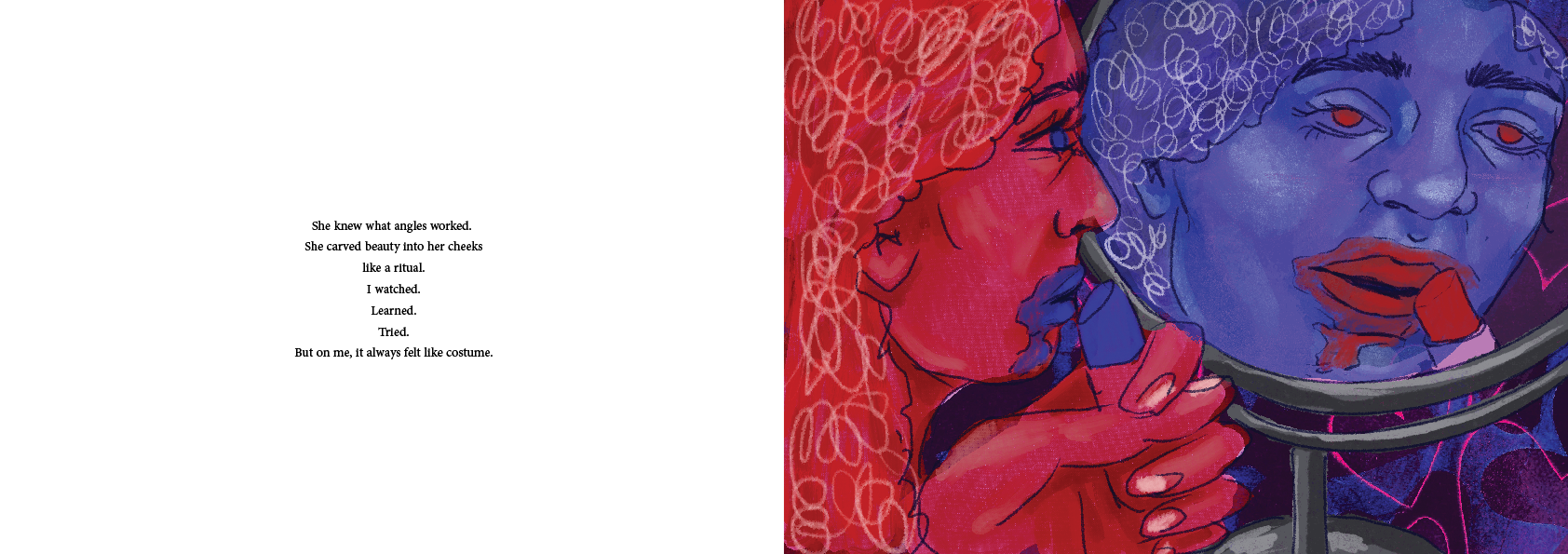
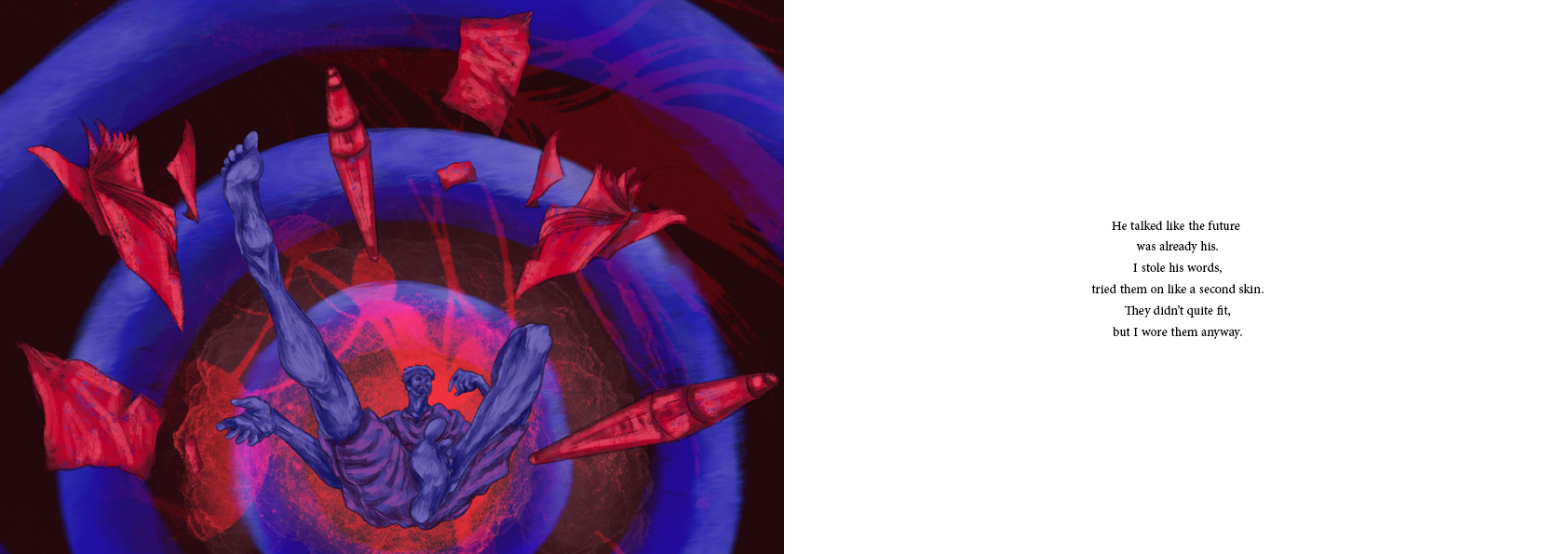

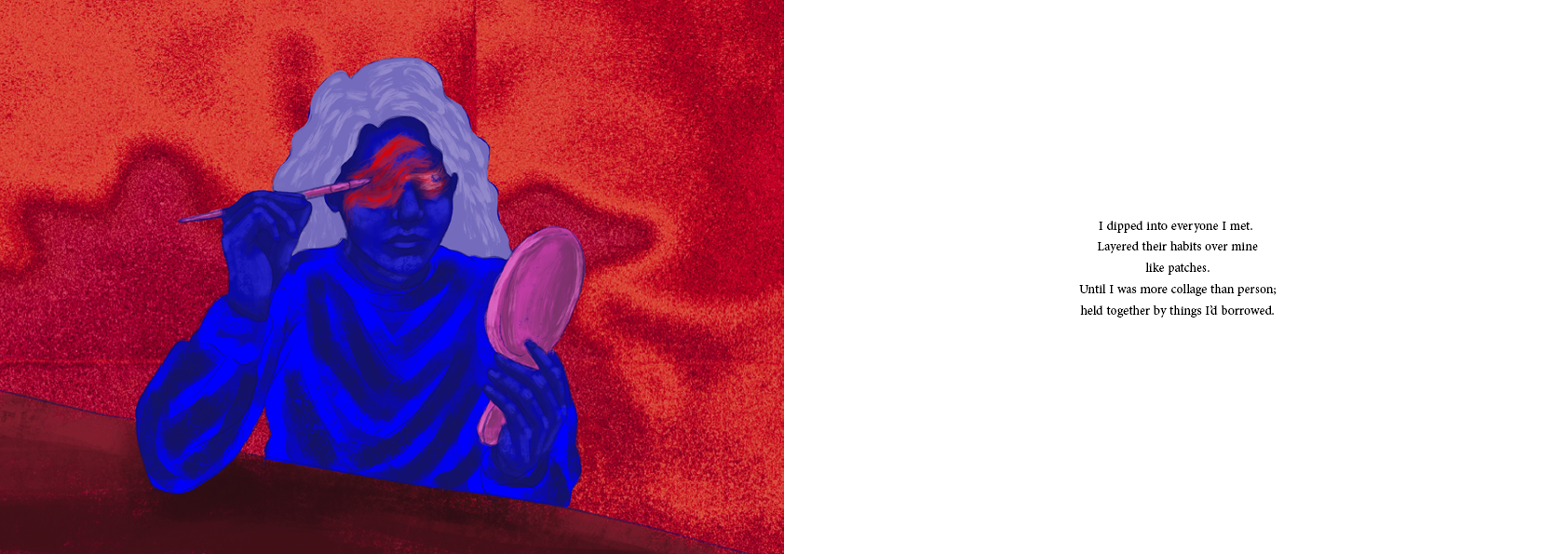

The Print
After a few failed versions, I finally printed out two proper copies of the book. One was on slightly thicker glossy paper, and the other on standard glossy stock. At first, this was just to keep a backup, but I ended up modifying one of them by stitching it along the side using the Japanese binding stitch. It was surprisingly easy to learn, and the thread added a handmade touch that looked really nice. For the thicker version, I used the glue binding machines in the bookmaking space at Bonington. It was my first time using them, and it turned out to be a completely new and enjoyable experience, giving the book a more polished and professional finish.


